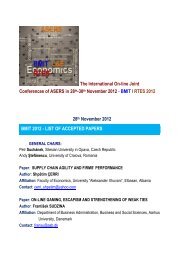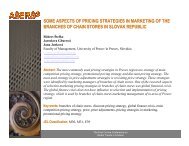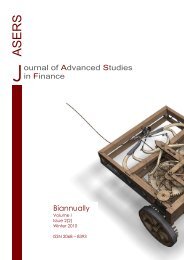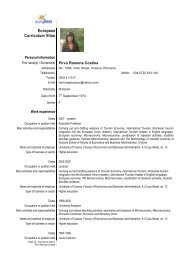Can Shift to a Funded Pension System Affect - ASERS
Can Shift to a Funded Pension System Affect - ASERS
Can Shift to a Funded Pension System Affect - ASERS
Create successful ePaper yourself
Turn your PDF publications into a flip-book with our unique Google optimized e-Paper software.
Theoretical and Practical Research in Economic Fields<br />
managed jointly by representatives from the trade unions and employers. Only in 1998, a more comprehensive<br />
legislation covered the operation of pension funds in<strong>to</strong> the financial markets.<br />
In the 1980s and 1990s pension fund assets grew from 14% <strong>to</strong> 80% per annum in real terms of GDP. This<br />
placed Iceland fourth among EU and EFTA countries in terms of the size of second pillar pension fund assets as<br />
a percentage of GDP, after the Netherlands, Switzerland and the UK. At the beginning of 2005 there were fortyeight<br />
pension funds in Iceland. Ten of them were no longer receiving contributions.<br />
The third pillar is characterized by voluntary private pension savings for which in 1998 tax incentive<br />
legislation was adopted as part of the general pension reform.<br />
In 2003 and 2004 the assets of Icelandic pension funds and life insurance was respectively 138.4 and<br />
146.2 as a percent of GDP (OECD 2005). The reason is that contribution <strong>to</strong> pension funds exceed benefits paid<br />
from them because of pensioners are few in proportion <strong>to</strong> working fund members. Furthermore, most of them<br />
have contributed <strong>to</strong> the fund only for short period of their working life ad so they are entitled only <strong>to</strong> relatively<br />
small benefits. As a consequence, pension funds fed on their own investments. In 2006 and 2007 the importance<br />
of pension funds relative <strong>to</strong> the size of the economy were 132,7 and 134 per cent of GDP, respectively. The<br />
situation changed dramatically in the 2008 when the assets of pension funds fell <strong>to</strong> 99.5 per cent of GDP. Due <strong>to</strong><br />
the sharp decline of GDP <strong>to</strong> -7.2 per cent in 2009, the ratio of assets of pension funds on GDP does not give any<br />
useful information.<br />
4. Data, methodology and empirical results<br />
The principal task in this paper is <strong>to</strong> search for a long-run equilibrium relationship and short-term dynamics<br />
between national savings and a set of explana<strong>to</strong>ry variables (here after, “Z”) like public pension provision and<br />
private pension funds that could affect savings patterns. In doing so we follow three steps. Firstly, we consider the<br />
orthogonal problem that usually arises when we work with financial variables. To overcome this peculiar aspect<br />
we implement the SURE methodology. Secondly we move our analysis <strong>to</strong> the study of the long-run relationship<br />
between national saving and a vec<strong>to</strong>r of exogenous variables “Z”. Finally we estimate, using a Kalman filter<br />
approach, a „backward-looking‟ process for national savings with parameters varying with fundamental component of<br />
the private pension plans. The time varying methodology allows us <strong>to</strong> recover an unobservable fac<strong>to</strong>r that could<br />
affect national savings. For each endogenous variables of the model it is therefore possible <strong>to</strong> observe how the<br />
respective coefficients have changed over time.<br />
4.1. Data analysis<br />
The choice of the sample 1997-2009 using monthly observation was essentially based on the need of<br />
analysing the behaviour of savings after substantial reforms of the pension systems <strong>to</strong>ok place. For the estimation<br />
of the Equations used in this work, the variables considered are 11 : SAV is the national aggregate saving of<br />
Iceland based on the current account definition of savings as the residual difference between <strong>to</strong>tal income,<br />
consumption and all the retirement saving generated by the three pillars.<br />
PAYG is defined as the logarithm of <strong>to</strong>tal expenditure on public pension benefits. The variable is from the<br />
Central Bank of Iceland. We expect a negative relationship between PAYG and national saving; PENS is defined<br />
as the logarithm of <strong>to</strong>tal expenditure on private pension funds and is expected with a positive sign. The Iceland<br />
PENS is manda<strong>to</strong>ry by law <strong>to</strong> pay at least 10% of all wages and salaries in<strong>to</strong> fully funded pension schemes that<br />
provide lifelong retirement and disability pensions; INS is the logarithm of insurance providing payment of a sum<br />
of money <strong>to</strong> a beneficiary on the death of the insured person or if the insured person reaches a certain age also<br />
known as life insurance and should have a positive impact on national savings. The monthly statistics for assets<br />
of pension funds including life insurance are compiled from monthly reports from 23 pension funds published by<br />
Central Bank of Iceland; INT is the nominal interest rate. We use money market rate (average rate on money<br />
market) as a measure of interest. The impact of interest rates on household savings is ambiguous because<br />
income and substitution effects work in opposite directions. Finally, the variable DR is the dependency ratio. It is<br />
calculated as the ratio of people over 64 <strong>to</strong> people aged 20-64 years. According <strong>to</strong> the life-cycle model, the higher<br />
the ratio of the elderly population <strong>to</strong> the working-age population, that is DR, the lower could be the aggregate<br />
saving because the old are retired and do not save while the young work and do save. Hence we expect a<br />
negative relationship between dependency ratio and national saving. The logarithms transformation of pension<br />
variables (PENS, PAYG and INS) reflects the general interest emphasized in the social security literature in<br />
relative versus absolute effect of this variables on national saving.<br />
11 Data source: IMF – Financial Statistics, Iceland Central bank and OECD statistics.<br />
16











